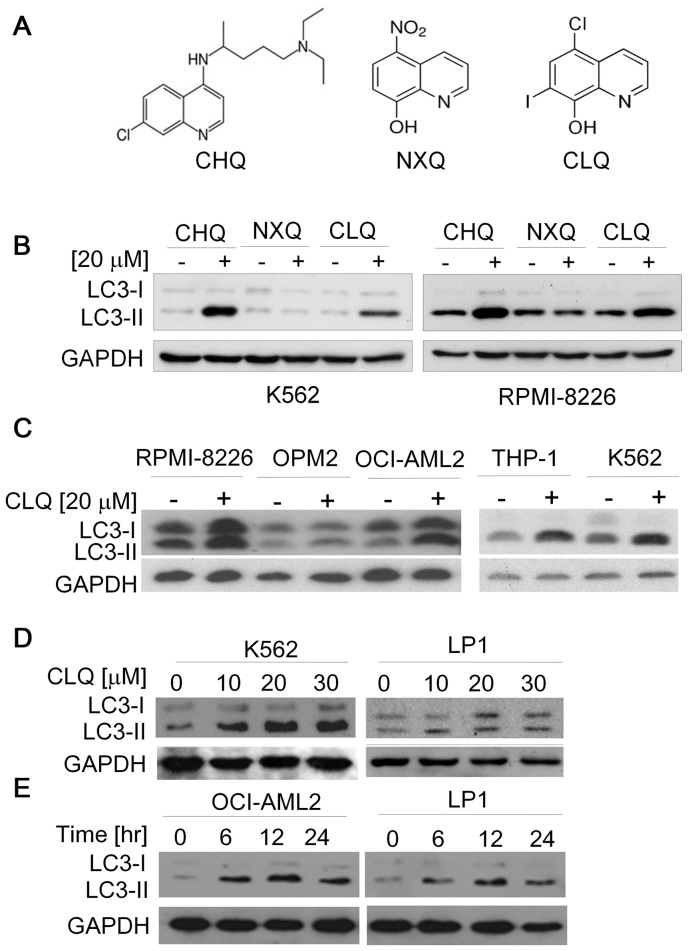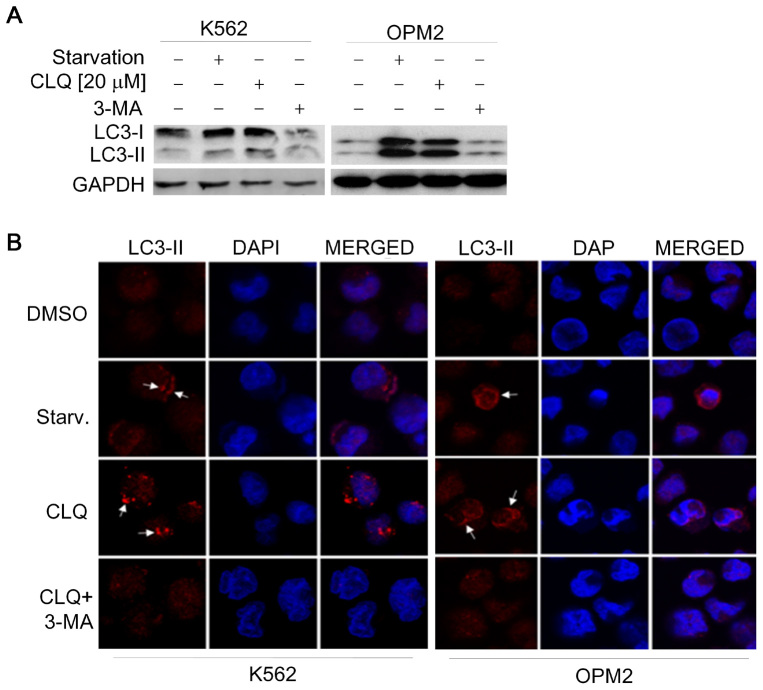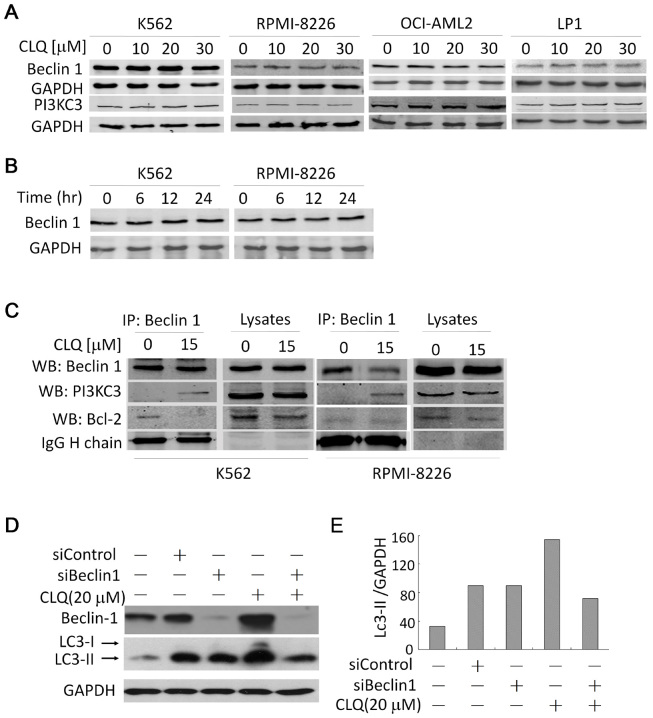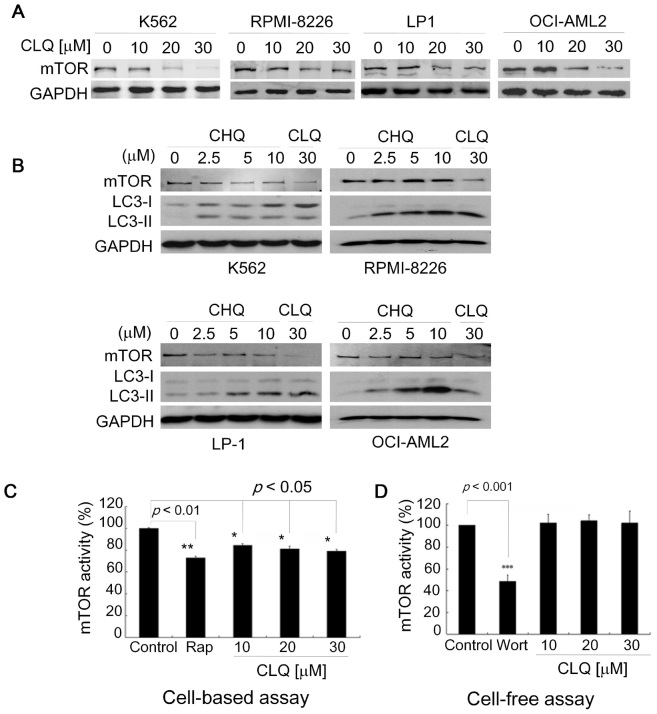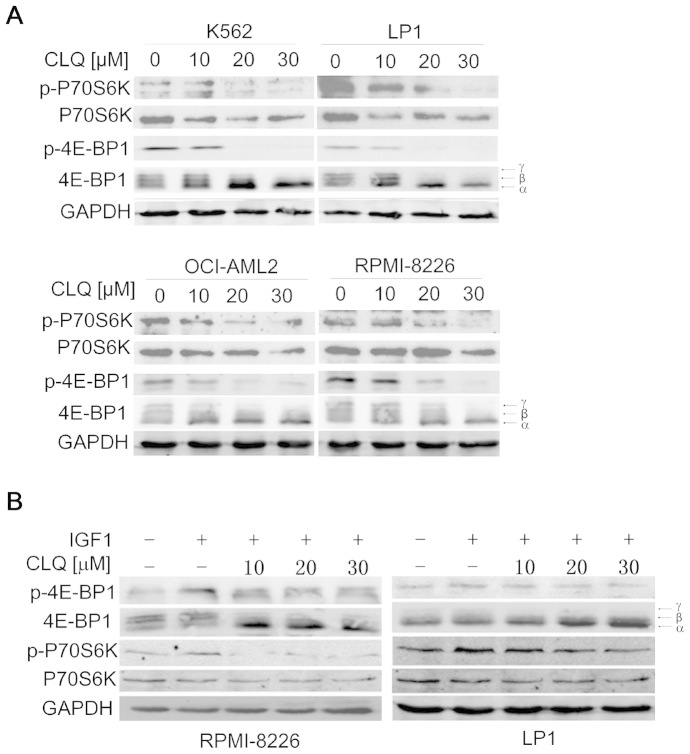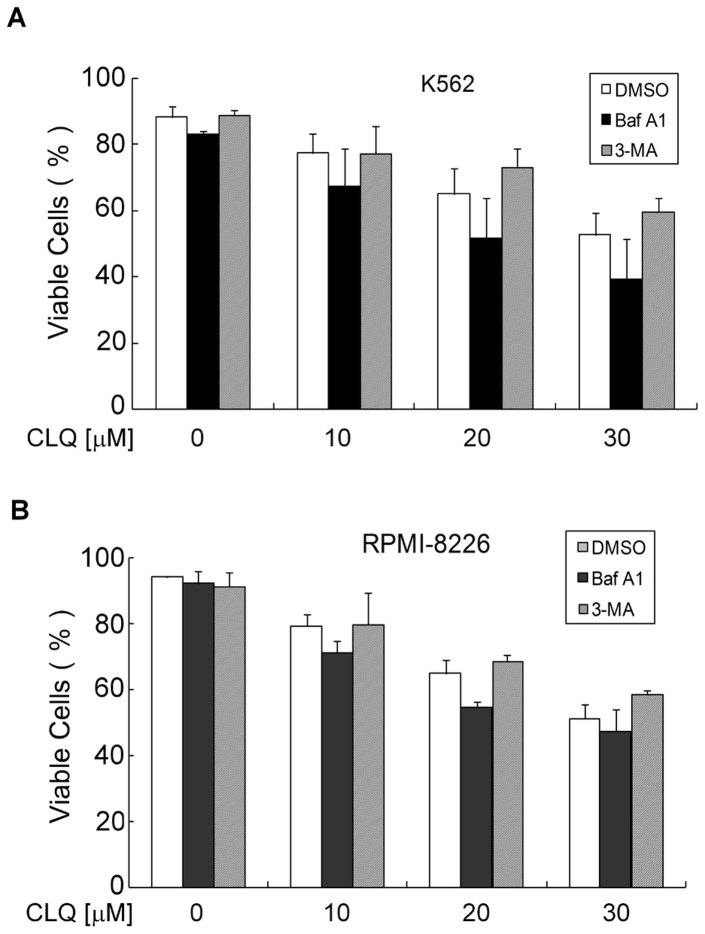Abstract
Clioquinol is an anti-microbial drug, and it was recently found to induce cancer cell death. In the present study, clioquinol was found to trigger autophagy by inducing LC3 lipidation and autophagosome formation which was abolished by an autophagy inhibitor 3-methyladenine. Further study showed clioquinol displayed no effects on PI3KC3 or Beclin 1 expression but downregulated the expression and the enzymatic activity of mammalian target of Rapamycin (mTOR), a critical modulator of autophagy. Moreover, clioquinol inhibited the catalytic activity of the mTOR complex 1, thus suppressing phosphorylation of P70S6K and 4E-BP1, two major proteins associated with autophagy in the mTORC1 signaling pathway. Clioquinol induced leukemia and myeloma cell apoptosis, however, addition of autophagy inhibitor 3-methyladenine attenuated this kind of cell death. Therefore, this study demonstrated that clioquinol induces autophagy in associated with apoptosis in leukemia and myeloma cells by disrupting mTOR signaling pathway.
Autophagy is a cellular process of self-destroy which is critical for cell survival in the condition of starvation. Upon stimulations such as starvation, Atg6 (Beclin 1), forms a core complex with class III phosphatidylinositol 3-kinase (PI3KC3), VPS15, and Atg14 to function as a key initiation signal1. In the autophagy process, isolated membranes formed in the cytosol elongate via an Atg7-dependent manner, and simultaneously recruit proteins or organelles to form a double-membrane organelle termed the autophagosomes. During this process, Atg8 (LC3) is cleaved at specific sites and lipidated to become LC3-II recruited to the autophagosome membrane. Increased LC3-II proteins and LC3-II-containing autophagosomes are important biomarkers of autophagy2. Loaded autophagosomes further fuse with lysosomes to form autolysosomes, resulting in degradation of the captured proteins/organelles by lysosomal enzymes3, thus protecting cells from life-threatening stress.
In mammalian cells, the target of rapamycin (mTOR) is critical for autophagy. mTOR is a well conserved protein in maintaining cell growth and survival as well as homeostasis. It forms a complex (mTORC1) with conjugation of Raptor, mLST8, AKTS1, and two negative regulators, PRAS40 and DEPTOR1,4,5. As a sensor of nutrient status, mTORC1 is suppressed in the absence of growth factors thus activating autophagy by interacting with ULK1. Down-regulated mTOR further suppresses phosphorylation of P70S6 kinase (P70S6K) and 4E-binding protein 1 (4E-BP1) to block protein synthesis6.
Autophagy can be initiated by a serial of triggers, including starvation, radiation, cell stress and chemicals. A recent study showed that bortezomib, the first FDA-approved proteasomal inhibitor for the treatment of multiple myeloma and mantle cell lymphoma, potently induces autophagy in head and neck squamous cell carcinoma cells by inducing autophagosome formation and complete autophagic flux3. Bortezomib-activated autophagy is significantly associated with endoplasmic reticulum stress, unfolded protein response, and formation of reactive oxygen species3,7. Clioquinol is an anti-parasitic agent that has shown anti-tumor activity as an inhibitor of both proteasomes and histone deacetylase (HDAC)8,9,10. A recent report demonstrated that clioquinol inhibits lysosomes in cultured astrocytes and neurons in the presence of zinc11. However, in the present study, we found that clioquinol induces autophagy in both leukemia and multiple myeloma (MM) cell lines by disrupting the mTORC1 signaling pathway.
Results
Clioquinol induces autophagy in myeloma and leukemia cells
LC3 lipidation is a key step in autophagosome formation and a biomarker of authophagic initiation2. To show the effect of clioquinol on LC3-II induction, we first compared the effects of chloroquine (a lysosomal inhibitor), clioquinol and its analog nitroxoline (Figure 1A) on LC3-II expression. As shown in Figure 1B, chloroquine induced LC3-II, which was predictable because chloroquine is an inhibitor of lysosomes thus preventing LC3-II-containing autolysosomes from degradation. Similar to chloroquine, clioquinol also increased the LC3-II level, however, as a very close analog of clioquinol, nitroxoline failed to increase LC3-II expression (Figure 1B). This result suggested that clioquinol was specifically active in induction of LC3 lipidation. Therefore we next determined the effect of clioquinol on autophagy in more leukemia and myeloma cell lines, including MM (RPMI-8226, OPM2) and leukemia (OCI-AML2, THP-1, K562) cells. As shown in Figure 1C, clioquinol led to marked increases of LC3-II in all cell lines examined and this induction was dose- and time-dependent (Figures 1D and E). LC3-II was induced as early as 6 h after clioquinol treatment (Figure 1E).
Figure 1. Clioquinol induces LC3-II up-regulation in both leukemia and multiple myeloma cells.
(A), the chemical structures of chloroquine (CHQ), clioquinol (CLQ) and nitroxoline (NXQ). (B), leukemia cell line K562 and multiple myeloma cell line RPMI-8226 were treated with CHQ, CLQ, or NXQ for 12 h, cells were collected and prepared for whole cell lysates followed by immunoblotting against LC3. (C), MM cell lines (RPMI-8226 and OPM2) and leukemia cell lines (OCI-AML2, THP-1 and K562) were treated with clioquinol (CLQ, 0 or 20 μM) for 24 h, cell lysates were then prepared for immunoblotting analysis against LC3. (D), K562 and LP1 cells were exposed to increasing concentrations of CLQ for 24 h followed by LC3 against specific antibodies. (E), OCI-AML2 and LP1 cells were treated with 20 μM of CLQ for 6, 12 or 24 h, followed by LC3 analysis. GAPDH was used as an internal control.
Clioquinol-induced autophagy is dependent on the PI3KC3 signaling pathway
The Beclin 1/PI3KC3 complex is a key player in modulating autophagy formation and inhibition of PI3KC3 activity will block autophagy. To investigate the effects of PI3KC3 and its associates, cells were co-treated with clioquinol and 3-methyladenine (3-MA), a specific inhibitor of PI3KC3. The results showed that increased LC3-II by clioquinol was decreased by 3-MA, suggesting that clioquinol induced autophagy via the Beclin 1/PI3KC3 pathway (Figure 2A). To confirm this finding, autophagosome formation was examined in K562 and OPM2 cells on a confocal microscope after exposed to clioquinol. Consistent with the immunoblotting results, confocal microscopic analyses showed that clioquinol markedly increased LC3-labeled puncta, an indicator of autophagosome formation, in a manner similar to starvation, but was abolished by 3-MA (Figure 2B). Therefore, these results demonstrated that the PI3KC3 signaling was involved in clioquinol-mediated autophagy.
Figure 2. Clioquinol-induced autophagy is blocked by an autophagy inhibitor.
(A), K562 and OPM2 cells were starved or treated with clioquinol (CLQ) for 6 h in the presence or absence of 3-methyladenine (3-MA), a specific inhibitor of autophagy, followed by LC3 analysis. (B), K562 and OPM2 cells were treated with 20 μM of CLQ or serum starvation for 6 h with or without 3-MA. Following treatment, cells were collected for immunofluoresence analysis with an LC3 antibody and Cy3-labled secondary antibody. Nuclei were stained with DAPI. Cells were then analyzed on a confocal fluorescent microscope. Autophagosome formation was defined by the accumulation of LC3, arrows indicated autophagosomes.
Clioquinol increases the formation of the Beclin 1/PI3KC3 complex
The study above demonstrated that PI3KC3 is important for clioquinol-induced autophagy. To elucidate the detailed mechanism, expressions of Beclin 1 and PI3KC3 was measured after clioquinol treatment. As shown in Figures 3A and B, neither Beclin 1 nor PI3KC3 was induced by clioquinol in all examined concentrations and time points in both MM and leukemia cells.
Figure 3. Clioquinol increases the formation of Beclin 1/PI3KC3 complex.
(A), K562, RPMI-8226, OCI-AML2, and LP1 cells were exposed to increasing concentrations (0, 10, 20, 30 μM) for 24 h, followed by immunoblotting assay for Beclin 1 and PI3KC3 expression. (B), K562 and RPMI-8226 cells were treated with 20 μM CQ for 0–24 h, followed by evaluation of Beclin 1 using a specific antibody. (C), K562 and RPMI-8226 cells were treated with 15 μM of CLQ or DMSO for 12 h, followed by immunoprecipitation with an anti-Beclin 1 antibody, followed by immunoblotting with specific antibodies as indicated. (D), shRNA of Beclin 1 in lentivisus was used to infect mouse myeloma cell line SP2/O, followed by CLQ treatment, and immunoblotting assay for Beclin 1 and LC3. (E), the densitometric analysis of (D).
Because Beclin 1 is silenced when complexed with Bcl-2, and it functions in the autophagy process when complexed with PI3KC3, we thus asked whether clioquinol affected the integrity of the Beclin 1/PI3KC3 and/or Beclin 1/Bcl-2 complex. To this end, K562 and RPMI-8226 cells were treated with clioquinol, followed by cell lysates preparation and co-immunoprecipitation with an anti-Beclin 1 antibody. As expected, PI3KC3 was increased but Bcl-2 was decreased in the complexes precipitated with an anti-Beclin 1 antibody in the clioquinol-treated cells (Figure 3C). These results indicated that clioquinol decreased the formation of Beclin 1/Bcl-2 complex but increased the formation of the Beclin 1/PI3KC3 complex.
To further evaluate the effects of Beclin 1 on clioquinol-induced autophagy, lentiviral shRNA of murine Beclin 1 was used to infect murine myeloma cells SP2/0, followed by evaluation of autophagic markers Beclin 1 and LC3. As shown in Figures 3D and E, Beclin 1 was downregulated by siBeclin 1. Notably, siBeclin 1 blocked the expression LC3-II expression raised by clioquinol (Figures 3D and E). These experiments therefore further demonstrated that clioquinol-induced autophagy was via the Beclin 1/PI3KC3 signaling.
Clioquinol inhibits the enzymatic activity of mTOR complex 1
Because mTOR is a well-conserved negative regulator and a main switch of autophagy12, we next evaluated the effects of clioquinol on mTOR expression and its activity in MM and leukemia cells. As shown in Figure 4A, clioquinol downregulated the expression of mTOR in a dose-dependent manner. Notably, although both chloroquine and clioquinol increased the protein level of LC3-II, clioquinol but not chloroquine significantly downregulated mTOR expression in all examined cell lines (Figure 4B), suggesting that clioquinol might act in a manner different from chloroquine. Next, we questioned whether clioquinol had any effects on mTOR activity. The results showed that in the presence of mTOR components, Rapamycin suppressed mTOR activity by 27% (p < 0.01) (Figure 4C), clioquinol inhibited the enzyme activity of mTOR by 16, 19 and 21% at concentrations of 10, 20 or 30 μM, respectively, which was significant (p < 0.05) compared with the vehicle control (Figure 4C). However, when analysis was performed in the recombinant human mTOR (provided by EMD Millipore) in the absence of mTOR associated components, clioquinol did not show marked changes in mTOR activity (Figure 4C), however, in the same system, it was inhibited to 51.5% by mTOR inhibitor wortmannin (Figure 4D). These results implicated that the reduction of the enzyme activity by clioquinol was dependent on the integrity of the mTOR complex.
Figure 4. Clioquinol downregulates the activity of mTOR complex 1.
(A), K562, RPMI-8226, LP1 and OCI-AML2 cells were exposed to clioquinol (0, 10, 20, 30 μM) for 24 h followed by mTOR expression analysis. (B), K562, RPMI-8226, LP1 and OCI-AML2 cells were treated with CHQ or CLQ for 6 h, followed by immunoblotting against LC3 and mTOR. (C), Whole cell lysates were prepared from RPMI-8226 cells followed by immunoprecipitation with an anti-mTOR antibody. The purified and enriched mTOR complexes were then treated with Rapamycin (Rap, 0.5 μM) or CLQ for 20 min, followed by incubation with ATP and measurement of p-P70S6K. (D), Recombinant mTOR kinase was treated with CLQ (10, 20, 30 μM) or wortmannin (10 nM) for 20 min. mTOR activity was measured by P70S6K phosphorylation, the substrate of mTORC1. The data represented the average of three independent experiments and were shown as mean ± SD; * p < 0.05, ** p < 0.01, *** p < 0.001, versus control.
Clioquinol inhibits the phosphorylation of P70S6K and 4E-BP1
To further verify the effects of clioquinol on the mTOR signaling, P70S6K and 4E-BP1, two key downstream substrates regulated by mTOR signaling pathway, were evaluated. These two proteins were measured in K562, RPMI-8226, LP1, and OCI-AML2 cells after clioquinol treatment. As shown in Figure 5A, clioquinol significantly decreased the phosphorylation of 4E-BP1 while 4E-BP1α, the hypo- or non-phosphorylated form, was increased. Phosphorylation of P70S6K was also inhibited by clioquinol (Figure 5B). Notably, clioquinol also negatively modulated the activation of 4E-BP1 and P70S6K in the presence of IGF-1, a growth factor and an autophagy inhibitor (Figure 5C). Therefore, these data demonstrated that clioquinol interfered with the mTOR signaling which was probably associated with induced autophagy by clioquinol in myeloma and leukemia cells.
Figure 5. Clioquinol inhibits phosphorylation of P70S6K and 4E-BP1, downstream signals of the mTOR complex 1.
(A), K562, RPMI-8226, OCI-AML2 and LP1 cells were treated with CLQ (0, 10, 20, 30 μM) for 24 h, protein levels of p-4E-BP1, total 4E-BP1, and p-P70S6K, and total P70S6K were measured by immunoblotting assay. (B), RPMI-8226 and LP1 cells were co-treated with IGF-1 (100 ng/ml) and CLQ (10, 20 or 30 μM) for 24 h, cell lysates were then prepared for measurement of the mTOR downstream signals 4E-BP1 and P70S6K. GAPDH was used as an internal loading control.
Clioquinol-induced cell death is partly attenuated by autophagy inhibitors
Autophagy is believed to play a role in chemoresistance13, however, in some conditions, it might induce apoptosis14. Clioquinol has been shown to induce apoptosis in both leukemia and myeloma cells9,10. To find out the effects of autophagy in clioquinol-induced cell death, leukemia cells K562 and MM cells RPMI-8226 were treated with clioquinol alone or along with 3-MA or bafilomycin A1 (BafA1) followed by Annexin V-PI staining. The result showed that clioquinol induced cell apoptosis because the percentage of cells with PI or Annexin V staining was increased (Figure 6). However, 3-MA, an autophagy inhibitor, but not BafA1, the inhibitor of lysosomes prevented clioquinol-induced cell apoptosis (Figure 6). In contrast, BafA1 enhanced apoptosis induced by clioquinol (Figure 6). Therefore, these results implicated that clioquinol-induced autophagy was cell death-associated.
Figure 6. Clioquinol-induced autophagy is associated with increased cell death.
K562 (A) and RPMI-8226 (B) cells were treated with CLQ (0, 10, 20 or 30 μM) in the presence of BafA1 (20 nM) or 3-MA (0.2 mM) for 24 h. The apoptotic cells were detected by FITC-Annexin V and PI staining followed by flow cytometric analysis.
Discussion
Chloroquine blocked the autophagy process by raising the lysosomal pH, which leads to inhibition of both fusion of autophagosome with lysosome and lysosomal protein degradation15, while its analog clioquinol was also demonstrated to inhibit lysosome thus blocking the autophagy processs in astrocytes and neurons as a zinc ionophore11. However, in the present study, we demonstrated that clioquinol induces autophagy in both leukemia and multiple myeloma cells independent of zinc but dysregulating the mTOR signaling pathway.
There are many triggers in autophagy induction, such as starvation, irradiation, viral infection, oxide injury, increased intracellular protein aggresomes, endoplasmic reticulum stress, and so on16. One of the major mechanisms involved in clioquinol-induced autophagy is probably the reactive oxygen species (ROS) which have been detected in HeLa cells after clioquinol treatment17, while ROS has been extensively involved in activation of autophagy by multiple pathways18. Another mechanism is probably associated with proteasome inhibition because clioquinol directly inhibits proteasomes in leukemia and myeloma cells9, while recent studies suggested that proteasome inhibitors such as bortezomib also stimulate autophagy by upregulating cell stress19. Therefore, it is predictable that clioquinol can induce autophagy as proposed in this study.
However, clioquinol induces autophagy in association with the increase of the PI3KC3/Beclin 1 complex and dissociation of Beclin 1/Bcl-2. In the early stage of autophagy, Beclin 1, a Bcl-2 homology 3 domain-containing protein, plays an essential role20. It recruits key autophagic proteins to a pre-autophagosomal structure, thereby forming the core complex consisting of Beclin 1, PI3KC3, and VPS15, blocking this complex will suppress autophagy20. It is reported that Beclin 1 or PI3KC3 is induced in starvation- and Rapamycin-induced autophagy21, however, clioquinol failed to induce expression neither Beclin 1 nor PI3KC3. In our study, clioquinol downregulates expression of Bcl-2, thus liberating Beclin 1 from Bcl-2 and promoting the formation of Beclin 1/PI3KC3 complex. Since PI3KC3 positively but Bcl-2 negatively regulates autophagy initiation, these results demonstrated that clioquinol inhibits the interaction between Beclin 1 and Bcl-2, antagonizes the inhibition of autophagy by Bcl-2 and increases the formation of Beclin 1/PI3KC3 complex, and hence stimulates autophagy. However, although Beclin 1 was not induced by clioquinol, knock-down of Beclin 1 by RNA interference partially blocked clioquinol-induced autophagy. This study thus suggests that both Beclin 1 alone and the Beclin 1/PI3KC3 complex are important for clioquinol-induced autophagy. Moreover, clioquinol disrupted the mTOR signaling pathway independent of AKT activity. Generally, the upstream signal PI3K/AKT or nutrients activate mTOR thus suppressing autophagy. Some PI3K inhibitors such as LY294002 and wortmannin induce autophagy via inhibiting PI3K/AKT/mTOR pathway22,23. However, different from these PI3K inhibitors, clioquinol has no effects on AKT activity but downregulates the expression of mTOR, which is essential for mTORC1 activity. Notably, inhibition of mTOR kinase activity by clioquinol depends on the integrity of mTORC1 because clioquinol failed to inhibit mTOR activity in the absence of its associated partners.
Autophagy is reserved as a survival manner across species, and is found in chemoresistance, therefore, inhibition of autophagy might be an important manner to augment efficacy of chemotherapy13. However, more and more studies have showed that induction of autophagy is probably associated with increased cell death. For example, the HDAC inhibitor SAHA was found to induce autophagic cell death24. Our recent study demonstrated that clioquinol can also inhibit HDACs10, but whether clioquinol-induced autophagy is due to its action as an inhibitor of proteasomes or as an inhibitor of HDAC is not clear yet, the present study showed that clioquinol induces both apoptosis and autophagy. Moreover, its action on apoptosis can be partly abrogated by 3-MA, a major inhibitor of autophagy. Interestingly, this apoptosis induced by clioquinol was not attenuated by chloroquine, a lysosome inhibitor, that blocks the autophagy flux. Therefore, clioquinol-induced autophagy is cytotoxic to leukemia and myeloma cells.
This and previous studies thus demonstrated that clioquinol induces autophagy in cancer cells. However, it differs from chloroquine, an analog of clioquinol, which increases autophagosomes by blocking the autophagy flux via inhibition lysosomal function25. Clioquinol-induced autophagy can be blocked by 3-MA and knockdown of Beclin 1, which suggests that clioquinol can trigger autophagy in the early stage. Notably, nitroxoline, the close analog of clioquinol failed to induce LC3-II, suggesting the the individual quinoline compounds might vary in the biological activity of the compound itself.
In conclusion, this study is the first report that clioquinol induces autophagy in MM and leukemia cells by increasing the formation of PI3KC3/Beclin 1 complex and disrupting the mTOR signaling pathway. This study helps for further understanding of clioquinol in the treatment of hematological malignancies.
Methods
Cell culture and agents
MM (LP1, RPMI-8226 and OPM2) and leukemia (OCI-AML2, K562 and THP-1) cell lines were maintained in Iscove's modified Dulbecco's medium and RPMI-1640 medium (Invitrogen, CA, USA), respectively, as described previously26. Clioquinol, chloroquine, nitroxoline, 3-MA, and BafA1 were obtained from Sigma-Aldrich (St. Louis, MO, USA).
Antibodies
Antibodies against mTOR, 4E-BP1, and p-4E-BP1 (Ser65), Bcl-2, and Beclin1 were obtained from Cell Signaling Technology (Danvers, MA, USA). An antibody against LC3 was obtained from Medical & Biological Laboratories (Nagoya, Japan). Antibodies against PI3KC3, P70S6K and p-P70S6K (Thr389) were purchased from Abgent (Suzhou, China). The antibody against GAPDH was purchased from BD Biosciences (Franklin Lakes, NJ, and USA). Horseradish peroxidase-conjugate secondary antibodies, mTOR antibody for immunoprecipitation, DAPI, Cy3-labeled goat anti-rabbit IgG and Rapamycin were purchased from Beyotime Institute of Biotechnology (Nantong, China).
Beclin 1 knockdown mediated by lentivirus
Scrambled control shRNA (siControl) and murine Beclin-1 shRNA (siBeclin 1) were synthesized by GenePharma, Suzhou, China. These shRNA constructs were then packed into lentivirus and applied for infection of mouse myeloma cells SP2/0. Forty-eight hours after infection, cells were treated with DMSO or 20 μM of CQ for 10 hours to measure the expression of Beclin 1 and LC3-II proteins using immunoblotting assay.
Cell apoptosis assay
Leukemia cell line K562 and MM cell RPMI-8226 were treated with CQ (0, 10, 20, 30 μM) with or without 3-MA (200 μM) or BafA1 (20 nM) for 24 h. Cells were harvested and washed twice with ice-cold Calcium-free phosphate buffered saline (PBS), then re-suspended in binding buffer at 1 × 106 cells/ml. Apoptotic cells were double-stained for 15 min with Vybrant Apoptosis Assay Kit according to the manufacturer's instruction (Invitrogen), and subsequent analysis on a FACS Calibur® flow cytometer (Becton Dickinson). The immunoblotting assays were performed as described previously27. IRDye 680 goat anti-mouse and IRDye 800CW goat anti-rabbit antibodies were from Odyssey (San Ramon, CA, USA).
Immunofluorescence
Viable MM and leukemia cells (2.5 × 104) were spread on glass slides by centrifugation at 500 rpm (400 × g) for 5 min using a cytospin system (Thermo Fisher). Cells were fixed and staining with an anti-LC3 antibody (MBL, Nagoya, Japan) at 4°C, followed by staining with Cy3-labeled goat anti-rabbit IgG and DAPI (5 μg/ml). All samples were analyzed on a Nikon confocal microscopy (EZ-C1 FreeViewer) as described previously26.
Co-immunoprecipitation (Co-IP)
After treatment, cell lysates were prepared in RIPA lysis buffer as described previously26. Supernatants were incubated overnight at 4°C with specific primary antibodies Beclin 1 as needed followed by incubation with 40 μl of a 50% slurry of protein A agarose (Santa Cruz Biotechnology, Inc., CA, USA) with gentle rotation at 4°C for 2 h. Agarose beads were collected and washed 5 times with lysis buffer, followed by resuspension in 20 μl of 2 × SDS loading buffer. Samples were boiled before being subject to fractionation and immunoblotting analysis.
mTOR kinase assay
The activity of mTOR in both cell-free and cell-based systems was measured with colorimetric K-LISA mTOR activity kit (EMD Millipore, USA). In the cell-based assay, whole cell lysates were prepared from RPMI-8226 cells followed by co-immunoprecipitation with an anti-mTOR antibody. The elutes were then subject to clioquinol or Rapamycin treatment for 20 min, followed by incubation with adenosine triphosphate. In the cell-free system, recombinant mTOR kinase was first treated with clioquinol or wortmannin for 20 min, followed by incubation with adenosine triphosphate in the glutathione-coated 96-well plate where mTOR phosphorylates P70S6K at Thr389. The phosphorylated substrate was detected with anti-P70S6K (Thr389) antibody, followed by detection with HRP-antibody conjugate and TMB substrate (3,3′,5,5′,-tetramethylbenzidina). Relative activity of mTOR kinase was determined by reading the absorbance at the wavelength of 450 nm.
Statistical analysis
Results are expressed as mean ± SD from at least three independent experiments. Two-group comparisons were performed using Student's t-test. P values < 0.05 were defined as statistically significant.
Author Contributions
B.C., J.L., X.M., J.J., K.H. and Z.Z. performed experiments; Y.K. and J.W. provided key reagents; B.C., J.W. and X.M. designed the study; B.C. and X.M. wrote the main manuscript text. All authors reviewed the manuscript.
Acknowledgments
This project was partly supported by Natural Science Foundation of China (81272632, 81071935, 81320108023, 81101795, 81301906), by Jiangsu Provincial Natural Science Foundation (BK2011268, BK2010218), by National Basic Research Program of China (2011CB933501), by Suzhou City Science and Technology Program (SS201033), by the Priority Academic Program Development of Jiangsu Higher Education Institutions (PAPD), and Jiangsu Key Laboratory of Translational Research and Therapy for Neuro-psycho- diseases (BM2013003). Dr. Xinliang Mao is a member of Collaborative Innovation Center of Hematology, Suzhou, China.
References
- Chen X. & Yin X. M. Coordination of autophagy and the proteasome in resolving endoplasmic reticulum stress. Vet Pathol. 48, 245–253 (2011). [DOI] [PubMed] [Google Scholar]
- Kabeya Y. et al. LC3, a mammalian homologue of yeast Apg8p, is localized in autophagosome membranes after processing. Embo J. 19, 5720–5728 (2000). [DOI] [PMC free article] [PubMed] [Google Scholar]
- Li C. & Johnson D. E. Bortezomib induces autophagy in head and neck squamous cell carcinoma cells via JNK activation. Cancer Lett. 314, 102–107 (2012). [DOI] [PMC free article] [PubMed] [Google Scholar]
- Engelman J. A. Targeting PI3K signalling in cancer: opportunities, challenges and limitations. Nat Rev Cancer. 9, 550–562 (2009). [DOI] [PubMed] [Google Scholar]
- Populo H., Lopes J. M. & Soares P. The mTOR Signalling Pathway in Human Cancer. Int J Mol Sci. 13, 1886–1918 (2012). [DOI] [PMC free article] [PubMed] [Google Scholar]
- Jung C. H., Ro S. H., Cao J., Otto N. M. & Kim D. H. mTOR regulation of autophagy. FEBS Lett. 584, 1287–1295 (2010). [DOI] [PMC free article] [PubMed] [Google Scholar]
- Belloni D. et al. Bortezomib induces autophagic death in proliferating human endothelial cells. Exp Cell Res. 316, 1010–1018 (2010). [DOI] [PubMed] [Google Scholar]
- Jiang H. et al. Nitroxoline (8-hydroxy-5-nitroquinoline) is more a potent anti-cancer agent than clioquinol (5-chloro-7-iodo-8-quinoline). Cancer Lett. 312, 11–17 (2011). [DOI] [PMC free article] [PubMed] [Google Scholar]
- Mao X. et al. Clioquinol inhibits the proteasome and displays preclinical activity in leukemia and myeloma. Leukemia. 23, 585–590 (2009). [DOI] [PubMed] [Google Scholar]
- Cao B. et al. The antiparasitic clioquinol induces apoptosis in leukemia and myeloma cells by inhibiting histone deacetylase activity. J Biol Chem. 288, 34181–34189 (2013). [DOI] [PMC free article] [PubMed] [Google Scholar]
- Park M. H. et al. Clioquinol induces autophagy in cultured astrocytes and neurons by acting as a zinc ionophore. Neurobiol Dis. 42, 242–251 (2011). [DOI] [PubMed] [Google Scholar]
- Korolchuk V. I. & Rubinsztein D. C. Regulation of autophagy by lysosomal positioning. Autophagy. 7, 927–928 (2011). [DOI] [PMC free article] [PubMed] [Google Scholar]
- Pan Y. et al. Targeting autophagy augments in vitro and in vivo antimyeloma activity of DNA-damaging chemotherapy. Clin Cancer Res. 17, 3248–3258. [DOI] [PubMed] [Google Scholar]
- Gewirtz D. A. The four faces of autophagy: implications for cancer therapy. Cancer Res. 74, 647–651 (2014). [DOI] [PubMed] [Google Scholar]
- Shintani T. & Klionsky D. J. Autophagy in health and disease: a double-edged sword. Science. 306, 990–995 (2004). [DOI] [PMC free article] [PubMed] [Google Scholar]
- Marino G. & Lopez-Otin C. Autophagy: molecular mechanisms, physiological functions and relevance in human pathology. Cell Mol Life Sci. 61, 1439–1454 (2004). [DOI] [PMC free article] [PubMed] [Google Scholar]
- Chen H. L. et al. Synthesis and pharmacological exploitation of clioquinol-derived copper-binding apoptosis inducers triggering reactive oxygen species generation and MAPK pathway activation. Bioorg Med Chem. 17, 7239–7247 (2009). [DOI] [PubMed] [Google Scholar]
- Li Z. Y., Yang Y., Ming M. & Liu B. Mitochondrial ROS generation for regulation of autophagic pathways in cancer. Biochem Biophys Res Commun. 414, 5–8 (2011). [DOI] [PubMed] [Google Scholar]
- Jia L., Gopinathan G., Sukumar J. T. & Gribben J. G. Blocking autophagy prevents bortezomib-induced NF-kappaB activation by reducing I-kappaBalpha degradation in lymphoma cells. PLoS One. 7, e32584 (2012). [DOI] [PMC free article] [PubMed] [Google Scholar]
- Kang R., Zeh H. J., Lotze M. T. & Tang D. The Beclin 1 network regulates autophagy and apoptosis. Cell Death Differ. 18, 571–580 (2011). [DOI] [PMC free article] [PubMed] [Google Scholar]
- Tai W. T. et al. Mcl-1-dependent activation of Beclin 1 mediates autophagic cell death induced by sorafenib and SC-59 in hepatocellular carcinoma cells. Cell Death Dis. 4, e485 (2013). [DOI] [PMC free article] [PubMed] [Google Scholar]
- Takeuchi H. et al. Synergistic augmentation of rapamycin-induced autophagy in malignant glioma cells by phosphatidylinositol 3-kinase/protein kinase B inhibitors. Cancer Res. 65, 3336–3346 (2005). [DOI] [PubMed] [Google Scholar]
- Xing C., Zhu B., Liu H., Yao H. & Zhang L. Class I phosphatidylinositol 3-kinase inhibitor LY294002 activates autophagy and induces apoptosis through p53 pathway in gastric cancer cell line SGC7901. Acta Biochim Biophys Sin (Shanghai). 40, 194–201 (2008). [DOI] [PubMed] [Google Scholar]
- Shao Y., Gao Z., Marks P. A. & Jiang X. Apoptotic and autophagic cell death induced by histone deacetylase inhibitors. Proc Natl Acad Sci U S A. 101, 18030–18035 (2004). [DOI] [PMC free article] [PubMed] [Google Scholar]
- Walls K. et al. Lysosome dysfunction triggers Atg7-dependent neural apoptosis. J Biol Chem. 285, 10497–10507 (2010). [DOI] [PMC free article] [PubMed] [Google Scholar]
- Mao X. et al. A small-molecule inhibitor of D-cyclin transactivation displays preclinical efficacy in myeloma and leukemia via phosphoinositide 3-kinase pathway. Blood. 117, 1986–1997 (2011). [DOI] [PubMed] [Google Scholar]
- Mao X. et al. A chemical biology screen identifies glucocorticoids that regulate c-maf expression by increasing its proteasomal degradation through up-regulation of ubiquitin. Blood. 110, 4047–4054 (2007). [DOI] [PubMed] [Google Scholar]



